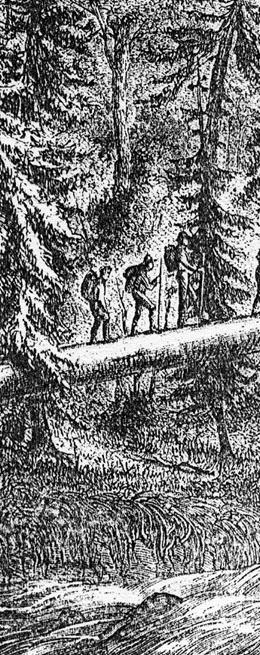On August 17, 1868, the Coleman party reaches the summit of Mount Baker, the first climbers in recorded history to do so. Mount Baker is one of the most striking and powerful features of the northwest corner of Washington. The party includes Edmund Coleman, an experienced climber from England; John Tennant, the first non-Indian settler on the Nooksack River and part of an earlier Coleman party attempt to climb the mountain; Thomas Stratton, a customs officer from Port Townsend; and David Ogilvy, a citizen of Victoria B.C. The party is gone for 14 days, and returns to the little settlement on Bellingham Bay.
His Third Attempt
Prior to 1868, Coleman had made two attempts to climb the mountain, both in 1866. On the second attempt (September 1866), the party had included John Tennant, who got sick and had to turn back. Coleman went on, got almost to the top, and then had to turn back due to a dangerous ice cornice. In August 1868, the Coleman party meant to change that record.
"The Mount Baker expidition (sic) is about ready to start, the party waiting on Mr. Coleman for that purpose," the editor of The Port Townsend Weekly Message wrote. "He is expected to arrive from Victoria today. I have got a small American flag in my possession belonging to the party which from Stratton of your Burgh says he will plant on the summit of Old Baker or leave his bones there as a warning to the adventurer who may follow in the footsteps of the intrepid Tom."
The party left on August 7, from John Tennant's homestead on the Nooksack River. The day was "clear and pleasant." They traveled by canoe to the Middle Portage on the river, a logjam that had to be circumvented. They camped for the night, then took off in the morning to present-day Lynden for breakfast. With them were two Lummi men, Squock and Talum, as well as two others.
The Menu
The provisions they took with them were simple. Their tents were canvas, but they had India rubber tarps, pans, and wool socks. Food was simple too. Coleman described the menu:
- Breakfast -- Tea, bread, bacon
- Dinner -- Bread, bacon, tea
- Supper -- Bacon, tea, bread
At the Forks, near present-day Deming, they met Umptalum, an important leader of the Nooksack people and father-in-law of Squock. After visiting with him for a while, the party decided to travel to the snowfields on Mount Baker by going up the middle fork of the Nooksack River. First they took the canoes as far as they could go, some 15 miles. Then they took out enough food for 10 days and put the rest into their canoes and stored them up in the trees.
Hard Climbing
The journey was hard. They climbed over fallen trees, under old logs, down steep ravines, over high rough rocks, and through "close-set jungle." Each time they stayed overnight they gave their campsites names such as "Camp Fatigue" and "Camp Doubtful." On the August 13 they entered into forest of Doug-fir, hemlock, spruce, and various shrubbery. It was cold and foggy. They finally arrived at a deep open basin with few trees. Snow was nearby. They were now 5,175 above sea level. They named the camp "Camp Hope" and ended up staying two days while they searched out a route.
Finally, they ascended to their last camp and then explored. "Went out on the snow a good long way," John Tennant wrote in his journal on Sunday, August 16, "& took a good look at the crevasse, glaciers, moraines & all the different kinds of stones & extinct craters ... Shot ptarmigan & a small furry animal about the size of a rat with the shape & motions of a rabbit."
The next day they left their Lummi guides, roped themselves up, and climbed. They left at five in the morning and hiked up to the vast ice and snow field. They took off their packs, put charcoal on their faces to protect their eyes, and put "creepers" (an early kind of ice climbing gear) on their feet. They headed up along a ridge.
Reaching the Summit
"Clear and snowhy [sic]," Tennant wrote later in his journal. "Light N.E. wind. Made an early start & made the ascent of the mountain & planted the flag on its summit & returned to camp well tired out but in great spirits."
They had stayed on top for an hour, leaving behind the flag and a copper plate with their names on it. They descended with ropes, and once they were past the dangerous section of crevasses, they slid the rest of the way down. They stayed at their camp for another day to give Mr. Coleman time to sketch and got off to an early start on the morning of the August 19. They were back at their canoes by 3 p.m. on August 20. Tennant was back at his homestead and harvesting peaches two days later.
Coleman continued to Bellingham and by sunset was back in company of friends. The next day he went over to the little settlement of Sehome and telegraphed his news to the world.

